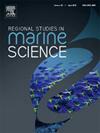Heavy metals toxicity in edible bivalves and risk exposure to humans through its consumption from Adyar Estuary, Tamilnadu, India – A baseline study
IF 2.1
4区 环境科学与生态学
Q3 ECOLOGY
引用次数: 0
Abstract
The Adyar estuary, situated at the heart of Chennai city, India, has been subjected to significant anthropogenic pollution over the past decade due to rapid urbanization and industrialization.
This study endeavored to explore the bioaccumulation patterns of heavy metals within bivalve species including Perna viridis, Mercenaria mercenaria, and Lamellidens marginalis. Additionally, it aimed to assess the concentrations of heavy metals present in water samples obtained from ten discrete stations within the Adyar estuary across different seasonal periods. To better understand the dynamics of contamination, metal pollutants including Cd, B, Cu, Fe, Mn, Pb, and Zn were analyzed in the soft tissues (Gill, Kidney, and Muscle) of the bivalves using Atomic Absorption Spectrophotometer (AAS) (ELICO's SL- 176). The study also investigated the seasonal changes in biochemical constituents affecting the nutritional quality of these edible bivalves following conventional methods, and estimated the risk (both carcinogenic and non-carcinogenic) to consumers. Results showed that the biochemical constituents of Perna viridis and Mercenaria mercenaria were comparatively lower than those of the freshwater bivalve Lamellidens Marginalis (p > 0.05). Heavy metal accumulation in the mussels followed the order Mn > Zn > Cu > Pb > Fe > Cd > B. The highest uptake of metals by the bivalves occurred during the post-monsoon season, while the least uptake was observed during the monsoon season. The overall metal burden for the studied species followed the descending order M. mercenaria > P. viridis > L. marginalis. The study indicated that both carcinogenic and non-carcinogenic risks to humans from consuming these mussels were higher due to the excessive accumulation of metals Zn and Mn in all three studied bivalves.
印度泰米尔纳德邦阿迪亚尔河口可食用双壳贝中的重金属毒性以及人类通过食用双壳贝接触重金属的风险 - 一项基线研究
阿迪雅河口位于印度钦奈市的中心地带,在过去的十年中,由于快速的城市化和工业化,该河口受到了严重的人为污染。本研究旨在探索重金属在双壳类动物(包括Perna viridis、Mercenaria mercenaria和Lamellidens marginalis)体内的生物累积模式。此外,该研究还旨在评估从阿迪亚河口十个离散站采集的水样中不同季节所含重金属的浓度。为了更好地了解污染的动态,使用原子吸收分光光度计(AAS)(ELICO SL- 176)分析了双壳类动物软组织(鳃、肾和肌肉)中的镉、硼、铜、铁、锰、铅和锌等金属污染物。研究还采用传统方法调查了影响这些食用双壳贝营养质量的生化成分的季节性变化,并估算了对消费者的风险(致癌和非致癌)。结果表明,Perna viridis 和 Mercenaria mercenaria 的生化成分相对低于淡水双壳贝 Lamellidens Marginalis(p > 0.05)。双壳贝类对重金属的吸收量在季风后季节最高,而在季风季节最低。研究物种的总体金属负荷从高到低依次为 M. mercenaria > P. viridis > L. marginalis。研究表明,食用这些贻贝对人类的致癌和非致癌风险都较高,这是因为在所有三种研究的双壳贝中,金属锌和锰的累积量都过高。
本文章由计算机程序翻译,如有差异,请以英文原文为准。
求助全文
约1分钟内获得全文
求助全文
来源期刊

Regional Studies in Marine Science
Agricultural and Biological Sciences-Ecology, Evolution, Behavior and Systematics
CiteScore
3.90
自引率
4.80%
发文量
336
审稿时长
69 days
期刊介绍:
REGIONAL STUDIES IN MARINE SCIENCE will publish scientifically sound papers on regional aspects of maritime and marine resources in estuaries, coastal zones, continental shelf, the seas and oceans.
 求助内容:
求助内容: 应助结果提醒方式:
应助结果提醒方式:


